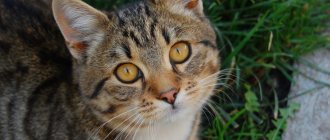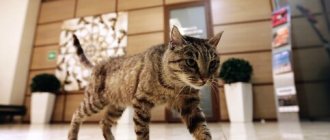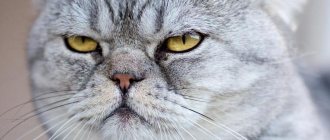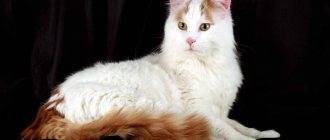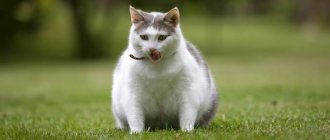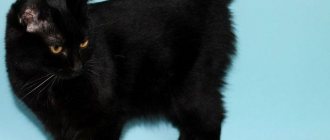Every second home has a cat or male cat, they are loved and cherished. These animals are bought by parents for their children, as well as by single people to stay at home in a cheerful company. How did these animals become so accustomed to people and become so close to us? How did they go through this long process of domestication and become true friends for us?
Content
- 1 Origin and evolution
- 2 Cat's story
- 3 Classification of cats 3.1 Classification of domestic cats
- 4.1 Physiology 4.1.1 Temperature
- 4.2.1 Leather
- 6.1 Non-communicable diseases
- 7.1 Cat and man
[edit] Origin and evolution
About 50 million years ago, there was a carnivorous animal called Dinictis, the ancestor of modern cats.
About 25 million years ago, the long-legged animal Pseudaelurus evolved and became more cat-like.
Among several species of wild cats that evolved and lived about 12 million years ago was the species Felis lunensis, also called the Martelli wild cat.
Modern Felidae cats are large and small, highly evolved, strong and fast predators designed to hunt and kill.
[edit] Cat's story
The history of cats is quite extraordinary, because she went from “deity” to the guise of a “witch.” Over the centuries, attitudes have also changed. However, today few people do not like her.
Eight thousand years ago, people and cats began to live together. The main find of archaeologists indicating this is the jaw bone of a cat. It was found in 1993 in the southern part of the island of Cyprus among the remains of the Neolithic layer of Kirikitia. This island was not originally the habitat of wild cats. Scientists believe that they were brought by the first settlers. It is assumed that cats were already domesticated.
Today the cat is one of the most popular pets. The word cat itself means either a biological species in general or a female cat. Males are called cats, cats, or also female cats. Kitten (plural kittens) is a baby cat. There are many breeds of cats.
Despite the fact that cats have been domesticated for a long time, they are able to survive in the wild. Cats usually hunt alone, but sometimes form small colonies. They are smart enough that some cats can use simple mechanisms (a door handle or a toilet flush valve). Cats also have a good sense of smell and hearing.
In 1758, Carl Linnaeus gave the name Felis catus to the domestic cat in his System of Nature.
Johann Christian von Schreber gave the wild cat the name Felis Silvestris in 1775.
[edit] Biology
[edit] Physiology
| Normal physiological indicators | |
| Body temperature | 38.6 °C |
| Heart rate | 110-140 beats per minute |
| Breathing rate | 16-40 breaths per minute |
[edit] Temperature
The body temperature of a domestic cat reaches 38.0-39.5° C. The body temperature of kittens and young animals is higher than that of adults. In adults and castrated animals, body temperature approaches the lower limit.
[edit] Breathing
The number of inhalations and exhalations in a healthy cat in a calm state and at normal room temperature is 20-30 per minute. At a higher temperature indoors or when moving, the number of inhalations and exhalations increases, and in a state of sleep it decreases.
[edit] Pulse
A cat's pulse rate under normal conditions is 110-130 beats per minute. This is significantly higher than the human heart rate. The pulse rate can be determined by listening to the heart. In cats, when moving or in pregnant females, it is much higher.
[edit] Puberty
Most cats reach sexual maturity by 7-9 months. In some individuals, under favorable conditions, puberty occurs at 6 months of life. From this time on, it is necessary to keep males and females separately to prevent accidental mating.
Cats develop physically much later. The most favorable age for mating is considered to be 18 months.
[edit] Anatomy of a cat
general structure of a cat
A cat is the perfection of nature. Cats have no equal in the variety of their physical capabilities. They master techniques such as jumping, climbing, balancing, crawling and sprinting, acrobatics, the ability to shrink, react with lightning speed and move slowly.
cat skeleton
The skeleton forms the skeleton of a cat's body. It consists of 240 individual bones and is essentially the same as those of all vertebrates: the skull sits at one end of the spine, and the other end goes into the tail (in a cat it consists of 26 vertebrae).
[edit] Leather
A cat's skin is very mobile and movable. This property of the skin provides an invaluable service when fighting or hunting.
The skin is covered with a dense network of small muscles, blood vessels and nerve fibers. Numerous sensitive cells react to every touch, heat or cold. In addition, the skin is covered with a thick layer of hair. A cat's skin is very important. Wool protects the cat from cold, sunburn, and skin damage. Tiny muscles located at the roots of the hair can raise the hair, as they say, on end. The cat's body in this case seems large and strong. The cat uses this effect when it is aggressive or frightened.
The skin contains sebaceous glands that secrete an oily fluid that the cat rubs into the fur when licking it, making it silky. At the same time, the skin and fur are so saturated that even in heavy rain the cat will never get wet to the skin. In addition, the secretions of the sebaceous glands contain some cholesterol, which is converted into vitamin D under the influence of sunlight.
During its daily toilet, the cat licks this vitamin necessary for the body.
[edit] Teeth
cat skull
The jaw of an animal always reflects the way it feeds. Predators, such as cats, are equipped with dagger-shaped angular teeth with which they can grab struggling prey, hold it tightly and kill it.
The molars, sharp and serrated, are used for cutting meat.
The six incisor teeth are almost never used when eating. The cat only uses them to cut off the remnants of meat from a thick bone.
When caring for skin and fur, they are simply necessary. Surprisingly cleverly, the cat picks out fleas from its skin with them...
[edit] Eyes
→ Cat eyes
cat eye
The cat's senses are well developed, as evidenced primarily by the eyes.
A cat's eyes can glow green at night. The cat's eye cannot see in absolute darkness, but in relative darkness, when the human eye no longer sees at all, the cat is well oriented. In all cases, she is helped by the organs of touch.
The pupils of a cat's eyes are sensitive to light: when illuminated, they narrow, and in the dark they become round. The protective organ of the eye is the third eyelid (nictitating membrane). A cat's field of vision is much wider than that of a human or a dog; A cat distinguishes colors, but in less contrast than a human.
[edit] Nose
→ Cat's nose
cat nose
A significant part of the space inside the cat’s head is allocated to the nose, which has external nasal passages that pass into cavities and into a nasal labyrinth of complex shape from ethmoid shells.[1]
A cold[2] and wet[3] nose in cats, as in dogs, is a sign of a healthy animal. The surface pattern of a cat's nose is as unique as a person's fingerprints.[2]
A cat's nose is moistened by secretions from the mucous membrane, as well as by licking, so a sleeping or just awakened cat's nose may normally be dry. However, if the nose is dry for a long time, it may be a sign of illness.[3]
Unlike a person, who has 5-20 million olfactory cells, a cat has 60-80 million. Cats can smell 14 times better than humans.[1]
In addition to the nose, a cat's olfactory organ is also the Jacobson tube behind the front incisors on the cat's upper palate. The cat begins to use this organ by raising its upper lip to concentrate on a specific odor (Flemen's smile).[1]
[edit] Ears and mustaches
Cat's ear Cat's whiskers
A cat has excellent hearing: it can also perceive ultrasound. Hearing helps her navigate the area and recognize the owner’s voice.
An important tactile organ is also the vibrissae - hairs located above the upper lip (whiskers), above the eyes and on the front legs. A cat suddenly deprived of whiskers may experience a nervous breakdown and lose the ability to navigate at night and avoid obstacles.
[edit] Tail
It is the end of the cat's spine, covered with muscles and skin.
The cat's tail is one of the balancing organs
In the book Catalog of Cats, Kenneth Anderson published an article in which he claims that it is the tail that helps the cat balance during jumps and turns, and when falling from a height, the tail serves as a real life preserver. When falling, a cat performs a trick called “self-righting,” in which the animal's tail, like a whip, moves rapidly from side to side, facilitating a landing on all fours. However, not everyone finds this version fair enough. Doctor of Veterinary Sciences Gordon Robinson gives one example that proves the opposite: if you take a tailless cat and, turning it over, release it even from a small height of a couple of meters, the animal will then have time to level itself without touching the floor.
The tail is an integral means of self-expression for cats.
Without a tail, a cat's appearance would lose its effectiveness - the tail is the final chord, emphasizing the plasticity and fragile grace of these animals. There is an opinion that without a tail, a cat cannot survive in its usual conditions. Indeed, this flexible and beautiful appendage performs several rather significant roles. With its help, cats can send many “messages”, in other words, communicate. But how then do tailless cats communicate? For example, a cat from the Isle of Man - nature endowed this rare cat with thick hair, but lacked a tail. However, they can do without it - and still feel great. Dr. Michael Fox states: even though one of the elements of communication has been lost, cats communicate not only with the help of their tail, they are able to send signals using movements of the head, whiskers, paws and even the pupils...
The tail says a lot
- Twitching of the tail. This usually means that the cat is very interested in something, such as a toy. However, this may indicate both the excitement of the hunt and the defense of territory, and aggression may follow. In this case, it is better not to touch the cat until it calms down.
- Tail between paws. This usually means that kittens are scared, especially if their ears are pinned back, their pupils are dilated, and they are squeaking. A frightened cat may scratch or bite. It is better to leave her alone in such a situation.
- Tail wagging. Strong swings of the tail in different directions indicate irritation, and if tension increases and the cat is filled with rage, you can even hear an angry howl. Fine wagging of the tail indicates excitement and curiosity.
- The tail is bristled. The animal is angry.
- The tail is strictly vertical. The cat is friendly and wants to give a greeting signal.
Caring for a sick animal
If your pet is diagnosed with FIV, remember the following rules:
- A sick cat should not be allowed outside (this is to prevent infection of other animals and protect your pet from various infections).
- Such animals need to be neutered.
- Immunocompromised cats should not be vaccinated.
- Every six months you need to undergo examinations (body weight, examination of lymph nodes, eyes, skin, etc.).
- Blood tests (general and biochemical tests) should be performed once a year.
The owner of an infected pet will have to follow some rules for caring for the cat.
In addition, you will have to give your cat the medications prescribed by the veterinarian. If there is a risk of missing any medication, you can ask a relative. It is also worth using the services of a cat hospital. In veterinary clinics where this service is provided, veterinarians are on duty around the clock - they will give the necessary injections and give pills. I have used a similar service: it is inexpensive, and the supervision of professionals is much better than the help of relatives.
In addition, the sick cat is prescribed a diet (for this you need to consult with the treating veterinarian). The food of an infected animal must be carefully balanced and healthy.
[edit] Domestic cat breeds
→ Cat breeds
According to various sources, there are about 256 breeds of domestic cats in the world. Many breeds were developed during the late 19th and early 20th centuries. Some breeds, such as the Sphynx or Scottish Fold, appeared as a result of random mutation. Breeds differ in size, body shape and weight, eye color, color, and coat length.
Cats are bred almost everywhere; according to experts, there are up to 600 million individuals in the world. In many countries, cat lovers' clubs have been created at the national level, which organize international exhibitions. Thanks to such exhibitions, many currently popular breeds have gained worldwide fame.
Concepts
Wolf dreams, tongues, dragons, Many Faces, Black Goat, Lion of Night, Faith in Seven (Unknown), Rhllor, Moon Mother, Drowned God, Great Shepherd, songs (“Lord with a Sorrowful Face”, “Seven Drunken Rowers”, “Rhoyne” song", "The Conqueror's Two Wives", "The Loose Merchant", Ships and maritime affairs ("The Fox", "The Frisky Monkey", "The Old Woman's Son", "The Valyrian", "Lady Ashenor"), Ibbenians, Summermen, curses and obscene vocabulary, bravi, Sea Lord, prostitution, War of the Five Kings, Night's Watch, "Valar morghulis", weirwood, Tears of the Fox, Sweet Dreams, basilisks.
| Chapters of "Feast of Vultures" | |
| Prologue (Pate of the Citadel) • Prophet (Eiron I) • Captain of the Guard (Areo Hotah I) • Cersei I • Brienne I • Samwell I • Arya I • Cersei II • Jaime I • Brienne II • Sansa I • Daughter of the Kraken (Asha I ) • Cersei III • The Fallen Knight (Aris I) • Brienne III • Samwell II • Jaime II • Cersei IV • Iron Captain (Victarion I) • The Drowned (Eiron II) • Brienne IV • Queenmaker (Arianne I) • Arya II • Alaina I (Sansa II) • Cersei V • Brienne V • Samwell III • Jaime III • Cersei VI • Naval Commander (Victarion II) • Jaime IV • Brienne VI • Cersei VII • Jaime V • Cat-Cat (Arya III) • Samwell IV • Cersei VIII • Brienne VII • Jaime VI • Cersei IX • The Princess in the Tower (Arianne II) • Alayne II (Sansa III) • Brienne VIII • Cersei X • Jaime VII • Samwell V | |
| POV Categories: Prologues and Epilogues • Areo Chapters • Arianna Chapters • Arys Chapters • Arya Chapters • Brienne Chapters • Victarion Chapters • Jaime Chapters • Sansa Chapters • Cersei Chapters • Samwell Chapters • Eiron Chapters | |
[edit] Diseases
Cat diseases are classified as non-infectious, infectious and parasitic.
External signs of the disease may be different, but in any case the animal becomes lethargic, tries to hide, the fur loses its brightness, and the appetite disappears. In such cases, you should immediately contact a veterinarian. Self-medication is unacceptable
.
[edit] Non-communicable diseases
are divided into several groups (depending on the cause and nature of the disease) These diseases are not transmitted from animal to animal. They can be associated with the external environment or food, some are caused by microorganisms. For example: poisoning, constipation, rickets, inflammation of the ear canal, inflammation of the liver, urolithiasis, nephrosis, hernia, various bruises, pneumonia, coat disorders, congenital disorders.
[edit] Infectious diseases
occur under the influence of microorganisms or viruses. The infection can be transmitted from one cat to another, as well as to other animals or even humans (for example, rabies). This is dangerous because symptoms appear only after the incubation period. Cats should be vaccinated against infectious diseases annually.
[edit] Parasitic diseases
caused by various parasites. Parasites are divided into external and internal, depending on their habitat (on the fur and skin, or in the internal organs of the cat).
[edit] Runny nose
Cats, just like people, can suffer from a runny nose (rhinitis) - inflammation of the mucous membrane due to hypothermia, infection or the use of caustic chemicals (washing powder, ammonia, etc.) in the house with a cat.
Characters
- Appears:
Brusco, Taleya, Breya, Arya Stark, Good Man, Wat, Casso, Tagganaro, Joss the Gloomy, Mirmello, Meralyn, Dareon, Una, Lanna, Sailor's Wife, Umma, Phantom Woman.
- Mentioned:
Catelyn Stark, Lotto Lornel, Beggo, Moredo Prestain, Red Roggo, Giloro Dotare, Gileno Dotare, Feather, Cossomo, Sallador Saan, Sphrona, Drunken Daughter, Jane Ulcer, Bashful Bethany, Assadora, Poetess, Moon Shadow, Sardinia Queen, Lady under the Veil, Belleguera Oteris, Belleguera Oteris (Bellonara's daughter), Bellonara Otheris, Lysa Arryn, Robert Arryn, Little Narbo, Quens, Alakio, Slu, Nightingale, Terro, Orbelo, Ezzelino, Septon Eustace, Samwell Tarly, Jon Snow, Aemon Targaryen .
[edit] Characteristics and behavior
[edit] Cat and man
A cat is a domestic animal that has not been completely domesticated by humans. The relationship between a cat and a person can be characterized more as a friendship or partnership than as a relationship between a master and a servant, which is typical, for example, for dogs.
The cat is an exceptionally freedom-loving animal, distinguished by its mobility, and can catch small animals. In rural areas, cats are used to kill mice. In these conditions, cats lead an independent lifestyle.
Purebred cats and ordinary European domestic cats, which are kept in apartments and urban environments, are deservedly called human companions. The owner of the cat shares a home with her and provides the animal with everything necessary. Cats have adapted to such conditions. The warmth of human housing and food become a prerequisite for their existence. Cats are affectionate and attached to humans, but their behavior is characterized by such traits as love of freedom, a desire to frolic and hunt. They strive to maintain a certain independence. While remaining a friend of a person, a cat never turns into his slave. The character of an animal is largely shaped by its environment, but heredity always predominates.
It is known that a cat is almost impossible to train, although you can instill in it certain skills. Therefore, circus programs rarely include acts with trained cats. From a very early age, cats are very sensitive to the characteristics of human behavior. The formation of their character and behavior patterns depends on this. Poor treatment of cats can cause them to become nervous, fearful, or overly aggressive. The calm and friendly character of the owner is transmitted to the animal. However, the character of an animal largely depends on heredity. There are known breeds that are characterized by increased aggressiveness. Representatives of such breeds are not recommended to be kept at home.
[edit] Body language and poses
In addition to the specific sounds that cats use, there is also a language of gestures and postures with which adult cats communicate with each other. These are movements of the tail, ears, paws, whiskers, eyes, head and whole body.
Tail movements are the main indicator of a cat's mood changes.
When a cat doesn't like something, she doesn't hide it. When defending, she uses her claws and teeth. If she is in danger, she tries to run away. Cats are very smart. They feel the mood of the owner and are devoted to him.
The cat gets used to its home. Therefore, it is extremely difficult for her to move to a new place of residence.
Cats also use their paws to attack their opponent. The whiskers change direction and twitch according to their mood. Wide open eyes show interest in what you are doing, half closed eyes express contentment.
The head is used for the so-called “butting”. This is how the cat wants to attract attention or shows affection.
The body can also tell a lot. Turning sideways, with an arched back and fluffy fur, the cat defends itself.
If you had to punish a cat, the animal may become offended by turning its back and starting to brush its fur.
The cat is man's friend
From wild nature to warm housing
Previously, cats lived only in the wild, but one day, having become human companions, they became helpers and companions - and this is how domestic cats appeared. These creatures are independent and clean, do not require careful care, and communicating with them is a pleasure.
Initially, such a domestic animal was valued for its ability to catch various rodents, so in Ancient Egypt and Rome cats were bred as useful household helpers. Nowadays, the mustachioed purr is an immense source of joy, which is simply admired and enjoyed in its presence.
How was it possible to domesticate such an independent creature? Most opinions agree that it was the Egyptians who tamed the wild cats that lived near their homes.
Ancient civilization treated these four-legged animals with special reverence - the cat was sacred to them. Poor treatment of mustachioed people was severely punished.
Time passed and domestic animals, in the form of cats, zealously “trampled” the entire globe - after Egypt they appeared in Greece, Georgia, and then in Europe.
[edit] Literature
- Angela Rickson, Illustrated Encyclopedia “Cat Breeds”, Astrel Publishing House, 2007.
- The Encyclopedia of the CatMichael Pollard AST, Astrel, Harvest 2009
- Illustrated encyclopedia of cats. - M.: Olma-Press, 2001. - ISBN 5-224-02331-9
- Melnikov I.V. Encyclopedia of cats and their owners. Tips for every day. - M.: Phoenix, 2005. - ISBN 5-222-05694-5
- Brem A. Animal life / Preface and comments by M. S. Galina and M. B. Kornilova. - M.: OLMA-PRESS, OJSC "Red Proletary", 2004. - 1192 p. — 5000 copies. — ISBN 5-224-04422-7. — ISBN 5-85197-214-9
- Encyclopedia of Animals Cyril and Methodius 2009
Geographical objects
Braavos (Long Canal, Fish Market, Palace of Truth, Mud Town, Braavos Titan, Blue Lantern, Ship of the Buffoons, Purple Harbor, Moon Pool, Isle of the Gods, Trash Pool, Flooded City, Palace of the Sea Lord, Aqueduct, Happy port", "The Spotted Cellar", "The Cat's House", "Seven Lamps", Overseas Sept, "Green Eel", Black and White House, House of the Red Hands), Valyria, Free Cities, Qohor, Westeros, Yi Ti, Arbor, Old Town, Twilight Valley, King's Landing, Gull City, Tyrosh, Lys, Port Ibben, Red Keep, Pentos, Volantis, The Steps, Vale of Arryn, Eastwatch, The Wall.
